Why is the warm gas-giant exoplanet WASP-107 b so puffy? Two independent teams of researchers have an answer.
7.05.2024
MIT astronomers observe elusive stellar light surrounding ancient quasars
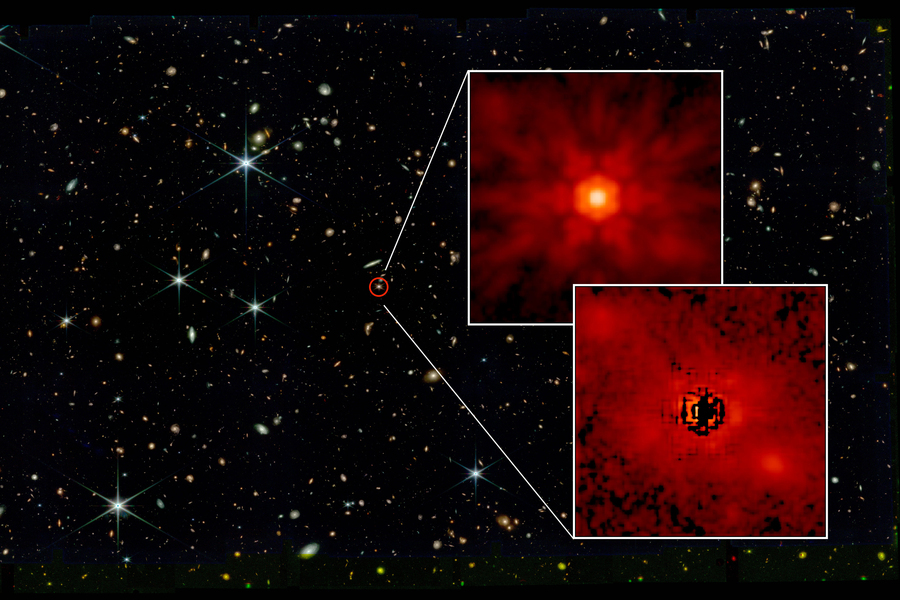
MIT astronomers have observed the elusive starlight surrounding some of the earliest quasars in the universe. The distant signals, which trace back more than 13 billion years to the universe’s infancy, are revealing clues to how the very first black holes and galaxies evolved.
Quasars are the blazing centers of active galaxies, which host an insatiable supermassive black hole at their core. Most galaxies host a central black hole that may occasionally feast on gas and stellar debris, generating a brief burst of light in the form of a glowing ring as material swirls in toward the black hole.
Quasars, by contrast, can consume enormous amounts of matter over much longer stretches of time, generating an extremely bright and long-lasting ring — so bright, in fact, that quasars are among the most luminous objects in the universe.
Because they are so bright, quasars outshine the rest of the galaxy in which they reside. But the MIT team was able for the first time to observe the much fainter light from stars in the host galaxies of three ancient quasars.
Based on this elusive stellar light, the researchers estimated the mass of each host galaxy, compared to the mass of its central supermassive black hole. They found that for these quasars, the central black holes were much more massive relative to their host galaxies, compared to their modern counterparts.
The findings, published today in the Astrophysical Journal, may shed light on how the earliest supermassive black holes became so massive despite having a relatively short amount of cosmic time in which to grow. In particular, those earliest monster black holes may have sprouted from more massive “seeds” than more modern black holes did.
“After the universe came into existence, there were seed black holes that then consumed material and grew in a very short time,” says study author Minghao Yue, a postdoc in MIT’s Kavli Institute for Astrophysics and Space Research. “One of the big questions is to understand how those monster black holes could grow so big, so fast.”
“These black holes are billions of times more massive than the sun, at a time when the universe is still in its infancy,” says study author Anna-Christina Eilers, assistant professor of physics at MIT. “Our results imply that in the early universe, supermassive black holes might have gained their mass before their host galaxies did, and the initial black hole seeds could have been more massive than today.”
Eilers’ and Yue’s co-authors include MIT Kavli Director Robert Simcoe, MIT Hubble Fellow and postdoc Rohan Naidu, and collaborators in Switzerland, Austria, Japan, and at North Carolina State University.
Dazzling cores
A quasar’s extreme luminosity has been obvious since astronomers first discovered the objects in the 1960s. They assumed then that the quasar’s light stemmed from a single, star-like “point source.” Scientists designated the objects “quasars,” as a portmanteau of a “quasi-stellar” object. Since those first observations, scientists have realized that quasars are in fact not stellar in origin but emanate from the accretion of intensely powerful and persistent supermassive black holes sitting at the center of galaxies that also host stars, which are much fainter in comparison to their dazzling cores.
It’s been extremely challenging to separate the light from a quasar’s central black hole from the light of the host galaxy’s stars. The task is a bit like discerning a field of fireflies around a central, massive searchlight. But in recent years, astronomers have had a much better chance of doing so with the launch of NASA’s James Webb Space Telescope (JWST), which has been able to peer farther back in time, and with much higher sensitivity and resolution, than any existing observatory.
In their new study, Yue and Eilers used dedicated time on JWST to observe six known, ancient quasars, intermittently from the fall of 2022 through the following spring. In total, the team collected more than 120 hours of observations of the six distant objects.
“The quasar outshines its host galaxy by orders of magnitude. And previous images were not sharp enough to distinguish what the host galaxy with all its stars looks like,” Yue says. “Now for the first time, we are able to reveal the light from these stars by very carefully modeling JWST’s much sharper images of those quasars.”
A light balance
The team took stock of the imaging data collected by JWST of each of the six distant quasars, which they estimated to be about 13 billion years old. That data included measurements of each quasar’s light in different wavelengths. The researchers fed that data into a model of how much of that light likely comes from a compact “point source,” such as a central black hole’s accretion disk, versus a more diffuse source, such as light from the host galaxy’s surrounding, scattered stars.
Through this modeling, the team teased apart each quasar’s light into two components: light from the central black hole’s luminous disk and light from the host galaxy’s more diffuse stars. The amount of light from both sources is a reflection of their total mass. The researchers estimate that for these quasars, the ratio between the mass of the central black hole and the mass of the host galaxy was about 1:10. This, they realized, was in stark contrast to today’s mass balance of 1:1,000, in which more recently formed black holes are much less massive compared to their host galaxies.
“This tells us something about what grows first: Is it the black hole that grows first, and then the galaxy catches up? Or is the galaxy and its stars that first grow, and they dominate and regulate the black hole’s growth?” Eilers explains. “We see that black holes in the early universe seem to be growing faster than their host galaxies. That is tentative evidence that the initial black hole seeds could have been more massive back then.”
“There must have been some mechanism to make a black hole gain their mass earlier than their host galaxy in those first billion years,” Yue adds. “It’s kind of the first evidence we see for this, which is exciting.”
Quelle: MIT Massachusetts Institute of Technology
----
Update: 18.05-2024
.
Black holes observed colliding when universe was only 740m years old
Glimpse of galactic merger, via James Webb telescope, may explain presence of monster black holes
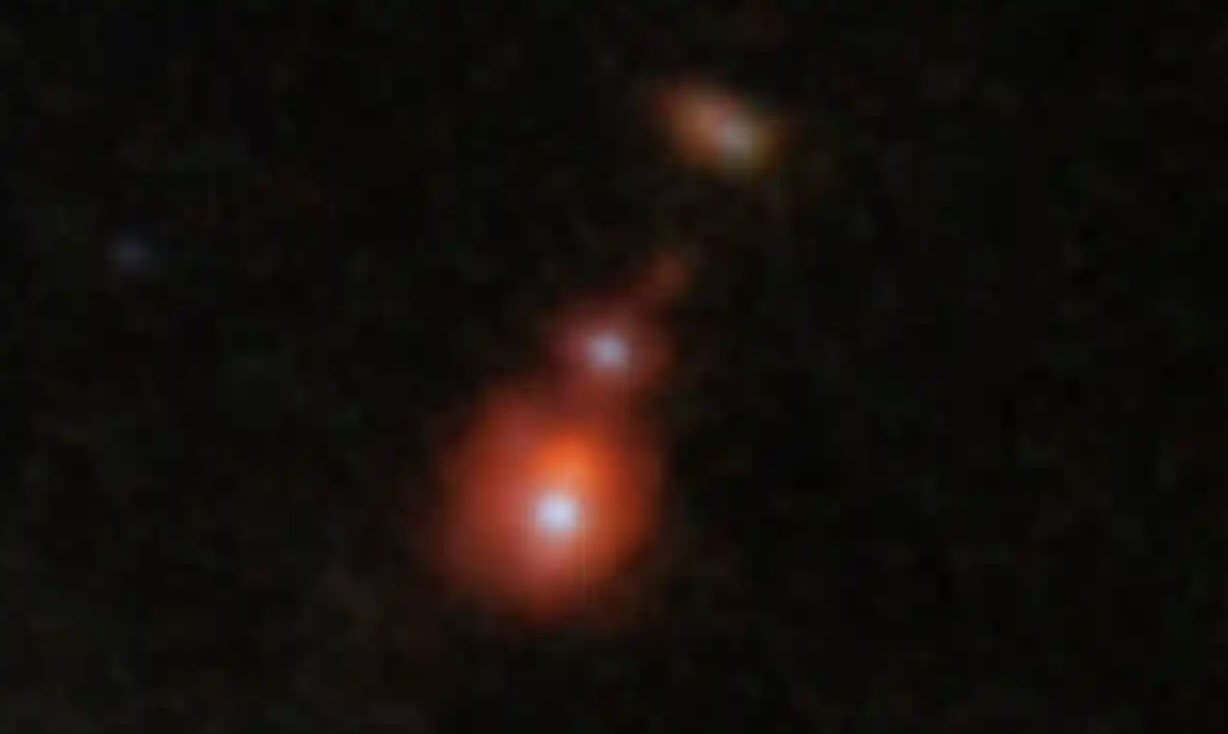
An image from Nasa showing the ZS7 galaxy system, where cosmologists detected a collision of black holes, one of which was estimated to be 50m times the mass of the sun.
A pair of black holes has been observed colliding in the ancient universe for the first time. The observations, by the James Webb Space Telescope, reveal a merger of two galaxies and the monster black holes at their centres when the universe was just 740m years old, about a 20th of its current age.
The discovery that massive mergers appear to have been common in the infant universe could help explain how supermassive black holes like the one at the heart of the Milky Way achieved such tremendous proportions.
Prof Roberto Maiolino, an astrophysicist at the University of Cambridge, and a member of team behind the observations, said: “One problem that we have in cosmology is explaining how these black holes manage to grow so big. In the past we have always talked about gobbling matter very quickly or being born big. Another possibility is that they grow very fast by merging.”
Until now it was not clear whether the merging of galaxies – which is known to have happened – would also result in the black holes at the centres morphing into a single cosmic sinkhole. Recent models have suggested that one of them would be kicked out into space to become a “wandering black hole”.
The latest observations use the Webb telescope’s ability to get to the far reaches of the cosmos and so have provided the first glimpse of galactic mergers in the distant past.
In the process of merging, black holes gobble up huge quantities of matter and also release a lot of energy, and this activity has distinctive spectral features that allow astronomers to identify them. This activity revealed the collision under way in a system called ZS7, with one of the two black holes estimated to have 50m times the mass of the sun.
“The mass of the other black hole is likely similar, although it is much harder to measure because this second black hole is buried in dense gas,” said Maiolino.
Subsequent observations showed that, of black holes detected at this time period, around a third appeared to be in the process of merging. “This could be a real channel for the rapid growth of early black holes,” he said.
Prof Andrew Pontzen, a cosmologist at University College London, who was not involved in the research, said: “One of the major blanks in our cosmic history book is where giant black holes, millions or billions of times the mass of sun, came from. Do they somehow get born big, or do they have to be built from initially smaller black holes that smash together to form the giants? This new evidence from [the Webb telescope] is indirect, but it helps suggest a major role for black hole collisions.”
Scientists hope in future to be able to make direct measurements of ancient collisions using the next generation of gravitational wave detectors, including the Laser Interferometer Space Antenna (Lisa) mission, which was recently approved by the European Space Agency.
The findings are published in the Monthly Notices of the Royal Astronomical Society.
Quelle: The Guardian
----
Update: 22.05.2024
.
Webb Cracks Case of Inflated Exoplanet
Data collected using NASA’s James Webb Space Telescope, combined with prior observations from NASA’s Hubble Space Telescope, show surprisingly little methane (CH4) in the planet’s atmosphere, indicating that the interior of WASP-107 b must be significantly hotter and the core much more massive than previously estimated.
The unexpectedly high temperature is thought to be a result of tidal heating caused by the planet’s slightly non-circular orbit, and can explain how WASP-107 b can be so inflated without resorting to extreme theories of how it formed.
The results, which were made possible by Webb’s extraordinary sensitivity and accompanying ability to measure light passing through exoplanet atmospheres, may explain the puffiness of dozens of low-density exoplanets, helping solve a long-standing mystery in exoplanet science.
Image: Warm Gas-Giant Exoplanet WASP-107 b (Artist’s Concept)
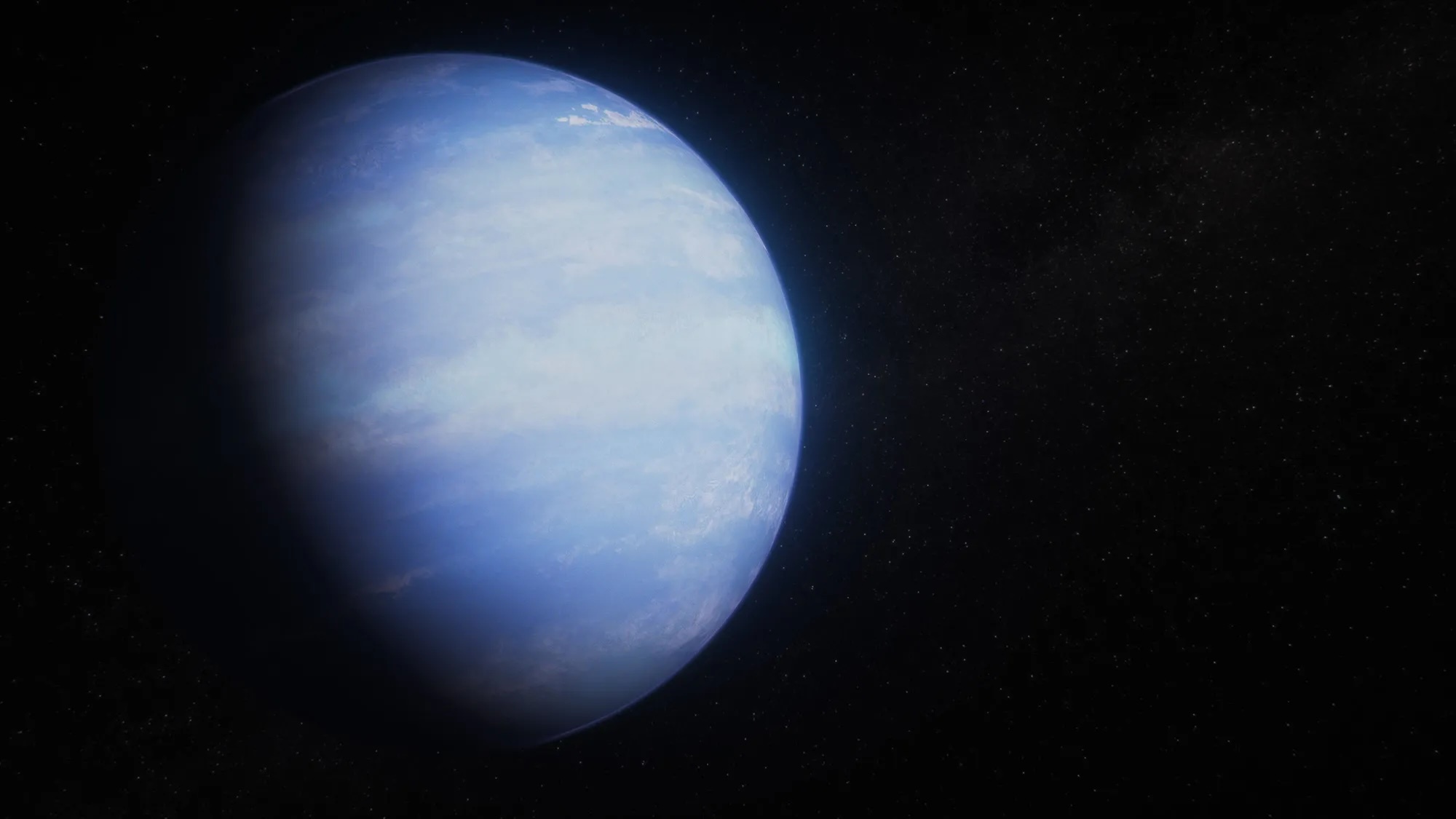
The Problem with WASP-107 b
At more than three-quarters the volume of Jupiter but less than one-tenth the mass, the “warm Neptune” exoplanet WASP-107 b is one of the least dense planets known. While puffy planets are not uncommon, most are hotter and more massive, and therefore easier to explain.
“Based on its radius, mass, age, and assumed internal temperature, we thought WASP-107 b had a very small, rocky core surrounded by a huge mass of hydrogen and helium,” explained Luis Welbanks from Arizona State University (ASU), lead author on a paper published today in Nature. “But it was hard to understand how such a small core could sweep up so much gas, and then stop short of growing fully into a Jupiter-mass planet.”
If WASP-107 b instead has more of its mass in the core, the atmosphere should have contracted as the planet cooled over time since it formed. Without a source of heat to re-expand the gas, the planet should be much smaller. Although WASP-107 b has an orbital distance of just 5 million miles (one-seventh the distance between Mercury and the Sun), it doesn’t receive enough energy from its star to be so inflated.
“WASP-107 b is such an interesting target for Webb because it’s significantly cooler and more Neptune-like in mass than many of the other low-density planets, the hot Jupiters, we’ve been studying,” said David Sing from the Johns Hopkins University (JHU), lead author on a parallel study also published today in Nature. “As a result, we should be able to detect methane and other molecules that can give us information about its chemistry and internal dynamics that we can’t get from a hotter planet.”
A Wealth of Previously Undetectable Molecules
WASP-107 b’s giant radius, extended atmosphere, and edge-on orbit make it ideal for transmission spectroscopy, a method used to identify the various gases in an exoplanet atmosphere based on how they affect starlight.
Combining observations from Webb’s NIRCam (Near-Infrared Camera), Webb’s MIRI (Mid-Infrared Instrument), and Hubble’s WFC3 (Wide Field Camera 3), Welbanks’ team was able to build a broad spectrum of 0.8- to 12.2-micron light absorbed by WASP-107 b’s atmosphere. Using Webb’s NIRSpec (Near-Infrared Spectrograph), Sing’s team built an independent spectrum covering 2.7 to 5.2 microns.
The precision of the data makes it possible to not just detect, but actually measure the abundances of a wealth of molecules, including water vapor (H2O), methane (CH4), carbon dioxide (CO2), carbon monoxide (CO), sulfur dioxide (SO2), and ammonia (NH3).
Image:Warm Gas-Giant Exoplanet WASP-107 b Transmission Spectrum (Hubble WFC3, Webb NIRCam, and Webb MIRI

Image:Warm Gas-Giant Exoplanet WASP-107 b (Transmission Spectrum: Webb NIRSpec)

Roiling Gas, Hot Interior, and Massive Core
Both spectra show a surprising lack of methane in WASP-107 b’s atmosphere: one-thousandth the amount expected based on its assumed temperature.
“This is evidence that hot gas from deep in the planet must be mixing vigorously with the cooler layers higher up,” explained Sing. “Methane is unstable at high temperatures. The fact that we detected so little, even though we did detect other carbon-bearing molecules, tells us that the interior of the planet must be significantly hotter than we thought.”
A likely source of WASP-107 b’s extra internal energy is tidal heating caused by its slightly elliptical orbit. With the distance between the star and planet changing continuously over the 5.7-day orbit, the gravitational pull is also changing, stretching the planet and heating it up.
Researchers had previously proposed that tidal heating could be the cause of WASP-107 b’s puffiness, but until the Webb results were in, there was no evidence.
Once they established that the planet has enough internal heat to thoroughly churn up the atmosphere, the teams realized that the spectra could also provide a new way to estimate the size of the core.
“If we know how much energy is in the planet, and we know what proportion of the planet is heavier elements like carbon, nitrogen, oxygen, and sulfur, versus how much is hydrogen and helium, we can calculate how much mass must be in the core,” explained Daniel Thorngren from JHU.
It turns out that the core is at least twice as massive as originally estimated, which makes more sense in terms of how planets form.
All together, WASP-107 b is not as mysterious as it once appeared.
“The Webb data tells us that planets like WASP-107 b didn’t have to form in some odd way with a super small core and a huge gassy envelope,” explained Mike Line from ASU. “Instead, we can take something more like Neptune, with a lot of rock and not as much gas, just dial up the temperature, and poof it up to look the way it does.”
The James Webb Space Telescope is the world's premier space science observatory. Webb is solving mysteries in our solar system, looking beyond to distant worlds around other stars, and probing the mysterious structures and origins of our universe and our place in it. Webb is an international program led by NASA with its partners, ESA (European Space Agency) and CSA (Canadian Space Agency).
Earliest and most distant galaxy ever observed
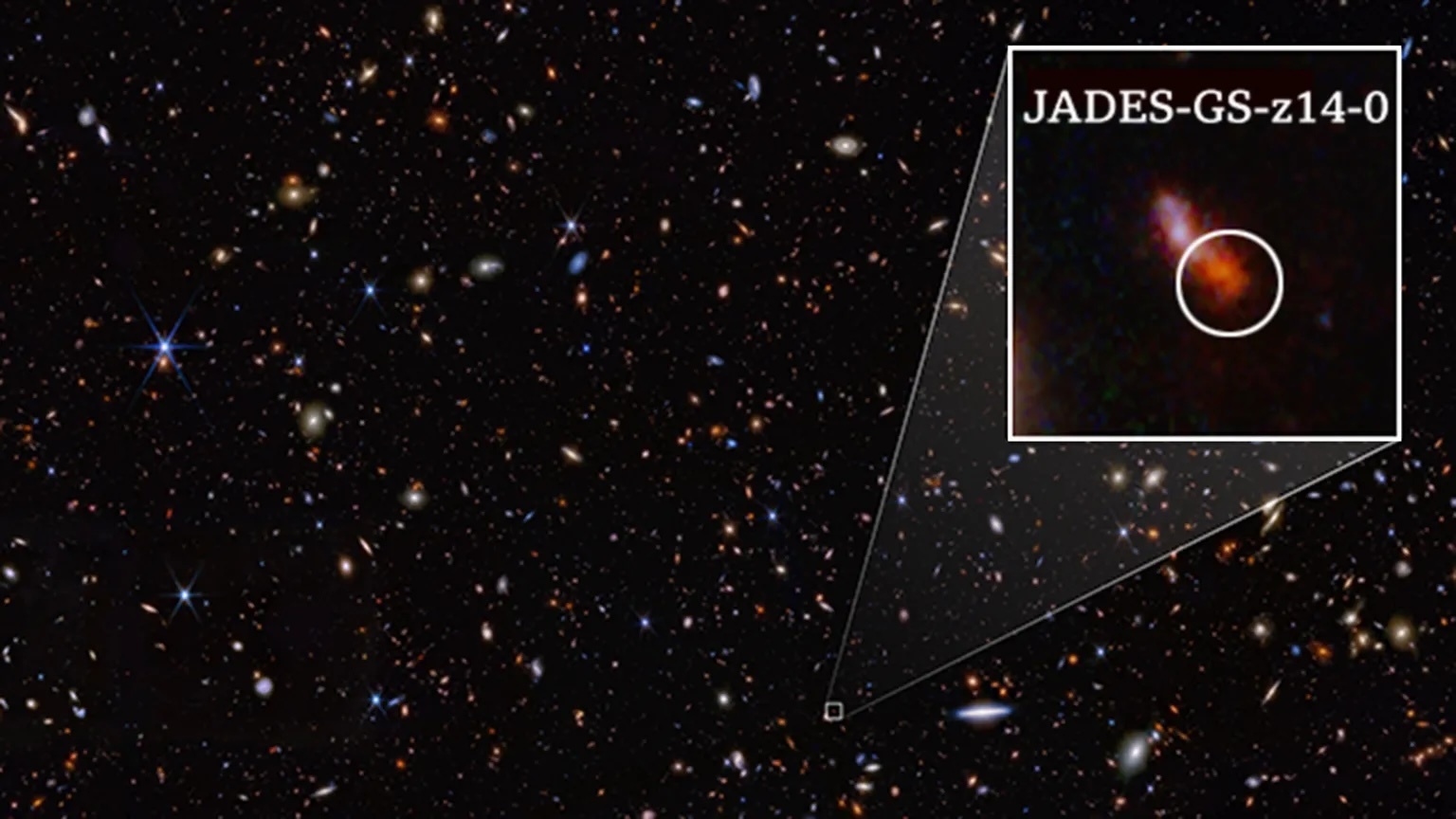
The distant galaxy (circled) sits next to, but far behind, another galaxy
The James Webb Space Telescope has smashed its own record for detecting the most distant known galaxy.
Called JADES-GS-z14-0, the collection of stars was spied as it was a mere 290 million years after the Big Bang.
Put another way - if the Universe is 13.8 billion years old, it means we're observing the galaxy when the cosmos was only 2% of its current age.
Webb used its huge 6.5m-wide primary mirror and sensitive infrared instruments to make the discovery.
The telescope's previous record holder was a galaxy seen at 325 million years after the Big Bang.
Astronomers say the most interesting aspect of the latest observation is not so much the great distance involved - as amazing as that is - but rather the size and brightness of JADES-GS-z14-0.
Webb measures the galaxy to be more than 1,600 light years across. Many of the most luminous galaxies generate the majority of their light via gas falling into a supermassive black hole. But the scale of JADES-GS-z14-0 indicates that is not the explanation in this case. Instead, the researchers believe the light is being produced by young stars.
"This much starlight implies that the galaxy is several hundreds of millions of times the mass of the Sun! This raises the question: how can nature make such a bright, massive, and large galaxy in less than 300 million years?" said Webb astronomers Stefano Carniani and Kevin Hainline.
Dr Carniani is affiliated to Scuola Normale Superiore in Pisa, Italy, and Dr Hainline is from the University of Arizona in Tucson, Arizona.
Dr Carniani is affiliated to Scuola Normale Superiore in Pisa, Italy, and Dr Hainline is from the University of Arizona in Tucson, Arizona.
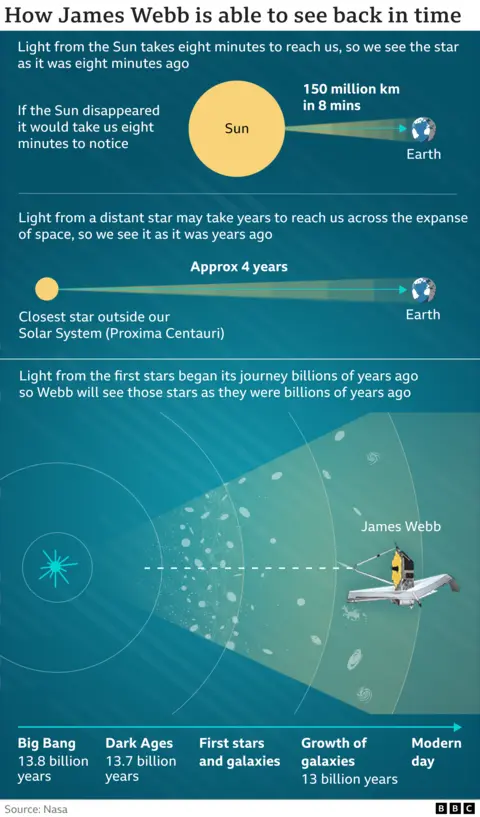
The $10bn James Webb Space Telescope (JWST) was launched in 2021 as a joint endeavour of the US, European and Canadian space agencies.
It was designed specifically to see farther across the cosmos - and further back in time - than any previous astronomical tool.
One of its key objectives was to find the very first stars to ignite in the nascent Universe.
These giant objects, perhaps many hundreds of times the mass of our Sun, were made only of hydrogen and helium.
They are theorised to have burnt brilliant but brief lives, forging in their nuclear cores the heavier chemical elements known in nature today.
In JADES-GS-z14-0, Webb can see a significant amount of oxygen, which tells researchers the galaxy is already quite mature.
"The presence of oxygen so early in the life of this galaxy is a surprise and suggests that multiple generations of very massive stars had already lived their lives before we observed the galaxy," added Drs Carniani and Hainline.
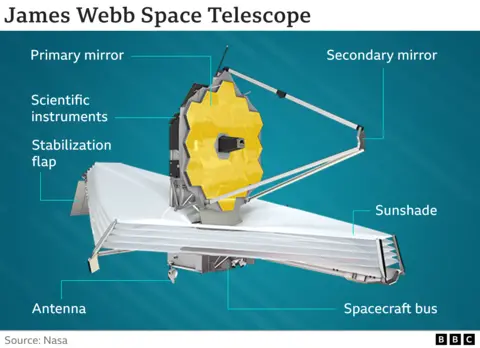
The "JADES" in the object's name stands for "JWST Advanced Deep Extragalactic Survey". It is one of a number of observation programmes using the telescope to probe the first few hundred million years of the cosmos.
"z14" refers to "Redshift 14". Redshift is the term astronomers use to describe distances.
It's essentially a measure of how the light coming from a far-off galaxy has been stretched to longer wavelengths by the expansion of the Universe.
The greater the distance, the greater the stretching. The light from the earliest galaxies is stretched from ultraviolet and visible wavelengths into the infrared - the part of the electromagnetic spectrum to which James Webb's mirrors and instruments were specifically tuned.
“We could have detected this galaxy even if it were 10 times fainter, which means that we could see other examples yet earlier in the Universe - probably into the first 200 million years,” said Prof Brant Robertson from the University of California at Santa Cruz.
The JADES discovery and its implications are described in a number of scholarly papers published on the arXiv preprint service.
Quelle: BBC
+++
